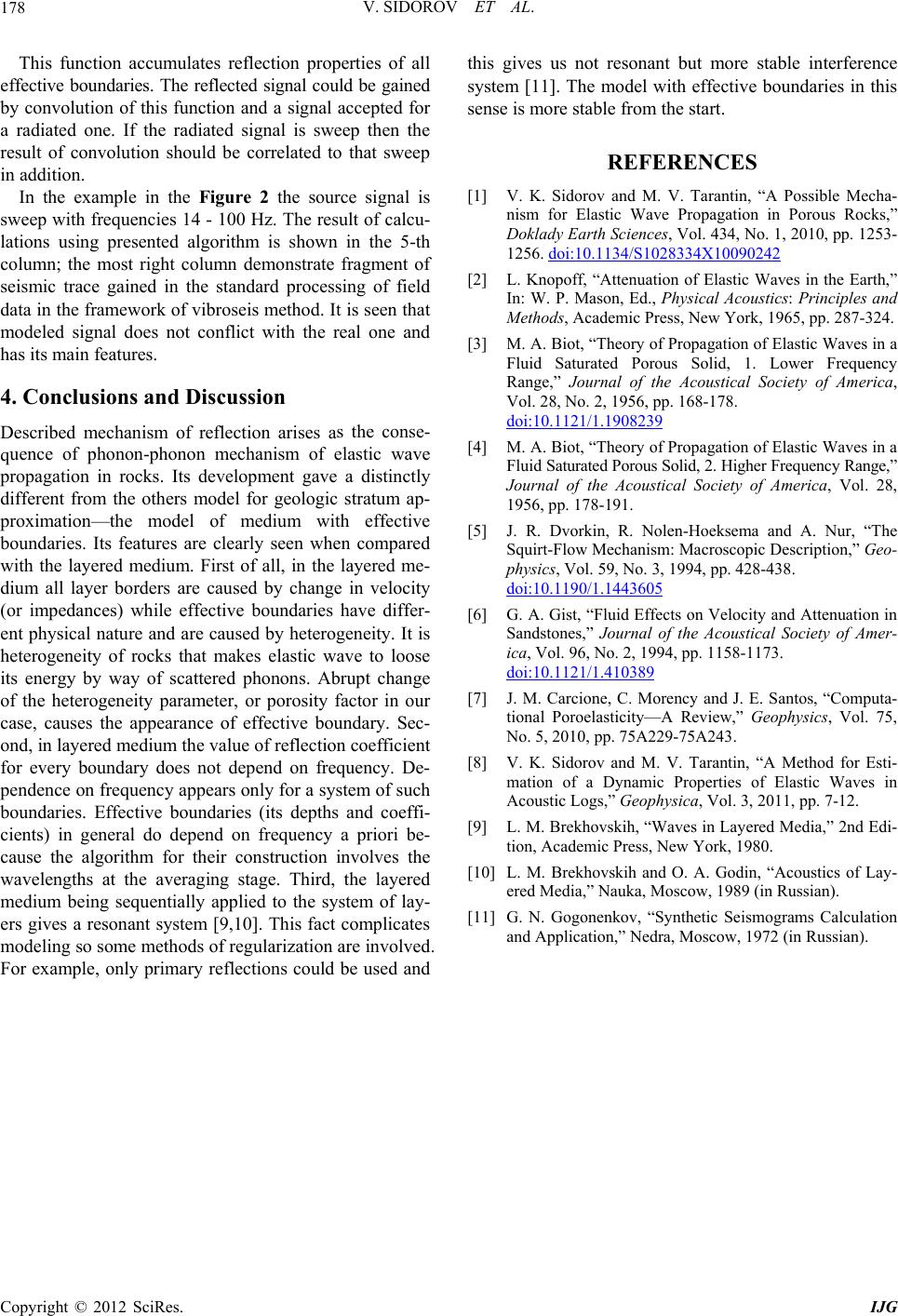
V. SIDOROV ET AL.
178
This function accumulates reflection properties of all this gives us not resonant but more stable interference
ef
ple in the Figure 2 the source signal is
sw
4. Conclusions and Discussion
s the conse-
REFERENCES
[1] V. K. Sidorov Possible Mecha-
fective boundaries. The reflected signal could be gained
by convolution of this function and a signal accepted for
a radiated one. If the radiated signal is sweep then the
result of convolution should be correlated to that sweep
in addition.
In the exam
eep with frequencies 14 - 100 Hz. The result of calcu-
lations using presented algorithm is shown in the 5-th
column; the most right column demonstrate fragment of
seismic trace gained in the standard processing of field
data in the framework of vibroseis method. It is seen that
modeled signal does not conflict with the real one and
has its main features.
Described mechanism of reflection arises a
quence of phonon-phonon mechanism of elastic wave
propagation in rocks. Its development gave a distinctly
different from the others model for geologic stratum ap-
proximation—the model of medium with effective
boundaries. Its features are clearly seen when compared
with the layered medium. First of all, in the layered me-
dium all layer borders are caused by change in velocity
(or impedances) while effective boundaries have differ-
ent physical nature and are caused by heterogeneity. It is
heterogeneity of rocks that makes elastic wave to loose
its energy by way of scattered phonons. Abrupt change
of the heterogeneity parameter, or porosity factor in our
case, causes the appearance of effective boundary. Sec-
ond, in layered medium the value of reflection coefficient
for every boundary does not depend on frequency. De-
pendence on frequency appears only for a system of such
boundaries. Effective boundaries (its depths and coeffi-
cients) in general do depend on frequency a priori be-
cause the algorithm for their construction involves the
wavelengths at the averaging stage. Third, the layered
medium being sequentially applied to the system of lay-
ers gives a resonant system [9,10]. This fact complicates
modeling so some methods of regularization are involved.
For example, only primary reflections could be used and
system [11]. The model with effective boundaries in this
sense is more stable from the start.
and M. V. Tarantin, “A
nism for Elastic Wave Propagation in Porous Rocks,”
Doklad y Earth Sc ienc es, Vol. 434, No. 1, 2010, pp. 1253-
1256. doi:10.1134/S1028334X10090242
[2] L. Knopoff, “Attenuation of Elastic Waves in the Earth,”
In: W. P. Mason, Ed., Physical Acoustics: Principles and
Methods, Academic Press, New York, 1965, pp. 287-324.
[3] M. A. Biot, “Theory of Propagation of Elastic Waves in a
Fluid Saturated Porous Solid, 1. Lower Frequency
Range,” Journal of the Acoustical Society of America,
Vol. 28, No. 2, 1956, pp. 168-178.
doi:10.1121/1.1908239
[4] M. A. Biot, “Theory of Propagation of Elastic Waves in a
Nolen-Hoeksema and A. Nur, “The
Flu id Saturated Porous Solid, 2. Highe r Frequenc y Range,”
Journal of the Acoustical Society of America, Vol. 28,
1956, pp. 178-191.
[5] J. R. Dvorkin, R.
Squirt-Flow Mechanism: Macroscopic Description,” Geo-
physics, Vol. 59, No. 3, 1994, pp. 428-438.
doi:10.1190/1.1443605
[6] G. A. Gist, “Fluid Effects on Velocity and Attenuation in
Sandstones,” Journal of the Acoustical Society of Amer-
ica, Vol. 96, No. 2, 1994, pp. 1158-1173.
doi:10.1121/1.410389
[7] J. M. Carcione, C. Morency and J. E. Santos, “Computa-
, “A Method for Esti-
Edi-
coustics of Lay-
ulation
tional Poroelasticity—A Review,” Geophysics, Vol. 75,
No. 5, 2010, pp. 75A229-75A243.
[8] V. K. Sidorov and M. V. Tarantin
mation of a Dynamic Properties of Elastic Waves in
Acoustic Logs,” Geophysica, Vol. 3, 2011, pp. 7-12.
[9] L. M. Brekhovskih, “Waves in Layered Media,” 2nd
tion, Academic Press, New York, 1980.
[10] L. M. Brekhovskih and O. A. Godin, “A
ered Media,” Nauka, Moscow, 1989 (in Russian).
[11] G. N. Gogonenkov, “Synthetic Seismograms Calc
and Application,” Nedra, Moscow, 1972 (in Russian).
Copyright © 2012 SciRes. IJG